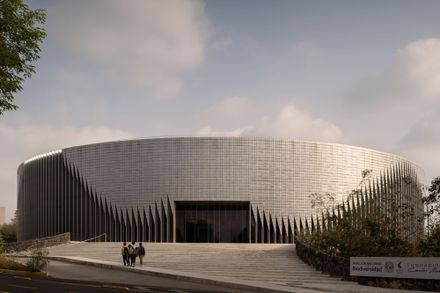National Pavilion of Biodiversity
National Pavilion of Biodiversity
Fernanda Ahumada + FREE
ARCHITECTS
Free, Fernanda Ahumada
MUSEOLOGY
Alejandro Nasta + Instituto Biología Unam
PROJECT TEAM
Karen García Villegas, Christiane Salem, Francisco Román, Alejandro Marin
EXECUTIVE PROJECT
Reactiva Arquitectura, Laura Dominguez, Ana Paula Herrera
FACADE CONSULTANT
Iasa
YEAR
2022
LOCATION
Ciudad De México, Mexico
CATEGORY
Museum
The National Pavilion of Biodiversity is a new space for UNAM, located in the cultural corridor of Ciudad Universitaria.
The project aims to grow and preserve the archive of the Institute of Biology, as well as to create thematic laboratories for the scientific study of the largest collection of dead species in Latin America.
The project responds from different perspectives. Conceptually, the architectural design proposes a radial scheme that arises from the interpretation of the Tree of Life and the idea that every living being is connected.
The stairs, located in the center of the building, represent the double helix of DNA, the molecule that contains the genetic information of all living beings and from which each species on the planet emerges.
Architecturally, the staircase located at the epicenter of the building is the element that connects the different spaces of the pavilion. From it, the paths lead to the exhibition rooms, the archive, and the laboratories, forming a radial layout that represents the infinite possibilities of biodiversity. In terms of materials, the glass facade with aluminum and the base made of local stone allows for a direct connection with the site.
The pavilion, with over eleven thousand square meters of construction, has exhibition rooms, multimedia rooms, a digital library, offices, storage areas, and laboratories, all distributed on three levels with a radial arrangement.
In the plan, each level has three rings. The first ring is intended for the public program and starts from the center with vertical circulation and permanent exhibitions. The subsequent ring is for private use and houses the collections.
The last ring, located on the edge of the facade, corresponds to the spaces for specialized consultation, laboratories, and curatorial offices. This mixture of areas on each floor allows for interaction between temporary and permanent users of the building.
The circular floor plan was leveraged to achieve two main objectives: on one hand, to unite all spaces through a single vertical core, and on the other hand, to create panoramic views of the 360-degree natural landscape through a facade that opens and closes in a wave-like form according to the specific needs of the program.
One of the major challenges was the distribution of the archives of the institute's four collections: mammals, reptiles, fish, and birds, due to the large number of square meters that needed to be allocated.
Each collection was strategically located to address climatic, storage, and future growth needs. For its proper functioning, there are high-density compactors for storage, which are placed on metal rails that move to store the largest number of species in the smallest possible space.
In addition, we proposed an orthogonal structure within the circular floor plan in order to optimize storage areas and allow for future growth.
The building is accessed from a stepped esplanade that seeks to accommodate visitors and connects with the cultural corridor.
On this floor, the largest exhibition area and three of the four collections are located along with the laboratories.
The first level is characterized by being the most enclosed according to technical requirements; here, one of the collections, the molecular biology laboratory, the auditorium, and the administrative offices are located.
Finally, the lower level responds to the unevenness of the terrain and contains the most publicly used spaces, such as the store, the cafeteria, and the digital library.
By locating these areas here, direct views of the quarry are taken advantage of, while creating a peaceful and introspective environment.
In addition, the privileged location of the site, immersed in the university cultural corridor, added spaces for dissemination of the program, with the aim of arousing visitors' interest in scientific careers.
Regarding its facades, the lower level functions as a showcase of the endemic biodiversity by directly integrating views into the natural space surrounding the building.
The two upper levels have a double facade of glass and perforated aluminum that allow for controlled views, and their folding responds to the lighting and ventilation needs of the interior spaces.
The result is a facade formed by thousands of 30x20 cm aluminum modules that move with the wind, a movement generated by the climatic conditions of the site and alluding to its importance in the evolution and permanence of biodiversity, creating a lively facade.
The base of the building is constructed with a quarry, a volcanic stone that is the most characteristic element of the local biodiversity, resulting from the explosion of Xitle that gave the name to the Pedregal area where Ciudad Universitaria is located.
It is worth noting that the same stone that was removed from the foundation was used for the construction of these walls.
The project can be summarized as a fusion of public and private spaces, where temporary users can coexist with the exhibits, but also with the site, thus arousing curiosity about everything behind the study and conservation of species.







































